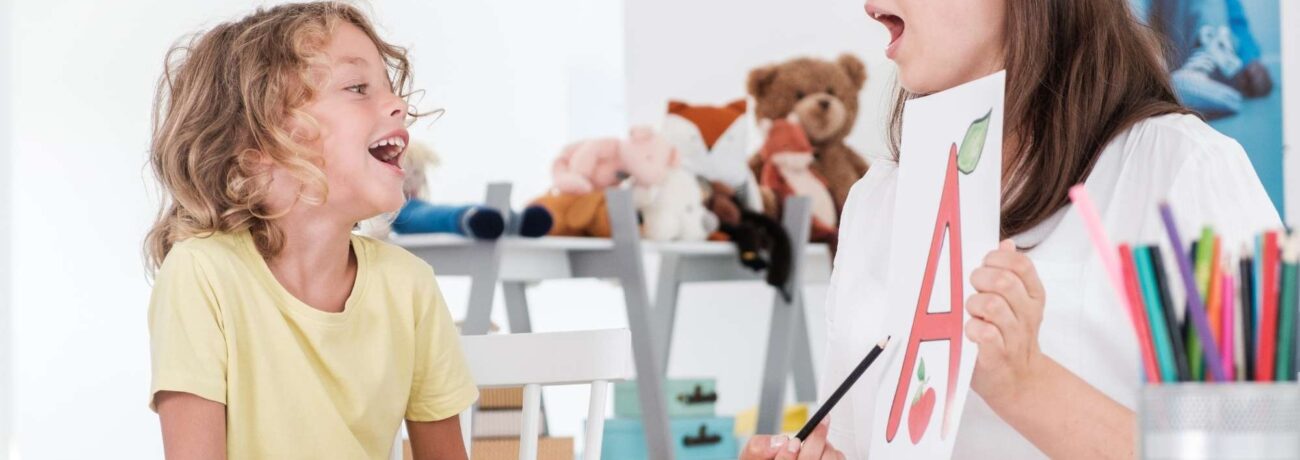Autism Activities for Speech Therapy Parents Can Use
Supporting children on the autism spectrum in developing speech and communication skills often requires more than traditional therapy sessions. Parents play a critical role in encouraging progress by using autism activities for speech therapy at home and in daily routines. These structured activities help children strengthen communication, improve social skills, and practice language development in fun and engaging ways.
For families in Connecticut, Massachusetts, and Colorado, Champions ABA offers individualized ABA therapy that integrates speech therapy goals into both in-home and center-based programs. Our whole-child approach ensures that every activity fits your child’s unique needs and daily routines. If you’re looking for personalized ABA speech therapy support in your area, contact Champions ABA today to schedule a diagnostic evaluation and begin your child’s progress journey.
What Are Speech Therapy Activities for Autism?
Speech therapy activities for autism are structured exercises designed to help children practice communication skills in ways that match their developmental level and sensory needs. Unlike general speech therapy exercises, autism-specific activities are adapted to address challenges such as echolalia, limited vocabulary, nonverbal communication, or difficulties with social interactions.
A speech therapy activity could be as simple as practicing animal sounds with a toddler or as complex as role-playing conversation skills with an older child. Each activity is tailored to meet the child where they are, promoting communication growth at home, in school, and in the community. At Champions ABA, these activities are built into in-home ABA therapy and center-based ABA sessions, ensuring children learn to apply skills consistently across different settings.
Best Autism Speech Therapy Activities at Home
Parents can reinforce speech therapy goals by weaving communication exercises into daily routines. The most effective autism speech therapy activities at home are interactive, fun, and directly connected to your child’s interests. These activities give children meaningful opportunities to practice language without feeling like they are “in therapy.”
Here are several parent-friendly activities:
- Animal Sound Imitation
Imitating animal noises helps young children develop vocalization skills and connect sounds to familiar objects. For example, holding up a toy cow while saying “moo” encourages the child to repeat and link the sound to the animal. - Choice-Making Games with Snacks or Toys
Offer two options and prompt your child to choose by pointing, gesturing, or speaking. “Do you want juice or water?” supports requesting skills and helps them practice spoken words or AAC. - Visual Schedules and First-Then Boards
Visual supports reduce frustration and guide children through routines while teaching essential sequencing language like “first” and “then.” - Storybook Reading with Core Words
Pause during reading to point to pictures and encourage your child to say or sign words like “go,” “more,” or “help.” Interactive books create a supportive environment for vocabulary growth. - Turn-Taking Games
Games like rolling a ball or playing peek-a-boo teach social reciprocity and lay the foundation for conversational turn-taking. - Echo + Expand Technique
If your child repeats words (echolalia), expand by adding one or two more words. For example, if they say “car,” you can respond with “red car” or “car go.” - Picture Exchange or AAC Use
For nonverbal children, picture exchange communication systems (PECS) or speech-generating devices help them express needs and build functional communication. - Pretend Play with Characters or Dolls
Role-playing with familiar toys builds expressive language and encourages children to practice new words in context.
When parents consistently use these strategies, children gain confidence and carry over their skills to school and community settings. If you’d like structured guidance, Champions ABA’s Parent Training program shows families in Connecticut, Massachusetts, and Colorado exactly how to implement these activities step by step at home.
Speech Therapy Activities by Age
Every child develops differently, and autism speech therapy activities should reflect a child’s developmental stage. By aligning activities with age and ability, parents can create a smoother learning experience.
Toddlers
Toddlers benefit from simple imitation and sensory play. Singing repetitive songs, mimicking facial expressions, and using sensory bins with hidden objects help them connect words with experiences.
Preschoolers
At this age, children can begin using core words and simple requests. Reading interactive books, practicing picture naming, and using first-then boards improve language comprehension and expressive vocabulary.
School-Age Children
Older children may practice storytelling, role-playing social interactions, and asking or answering questions. Social stories and structured conversations help them navigate group activities and peer interactions.
Champions ABA’s Pre-ABA Program is designed for younger children to start early interventions, while school-age children benefit from structured activities in both home and center-based environments.
Sensory-Friendly Communication Activities
Children with autism often face sensory challenges that affect their ability to focus on speech activities. Sensory-friendly adaptations create an environment where communication can flourish without overstimulation.
Some strategies include:
- Quiet Zones: Minimize background noise and distractions during practice.
- Sensory Play Integration: Pair speech prompts with sensory bins, water play, or textured objects.
- Fidget Tools and Timers: Allow children to self-regulate while keeping sessions short and predictable.
- Clear Transitions: Use visual timers or first-then boards to reduce frustration when moving between activities.
Preparing the environment is just as important as the activity itself. Champions ABA’s Center-Based ABA programs are designed with sensory-friendly spaces, ensuring children feel safe and supported while practicing communication skills.
How ABA Supports Speech Therapy Goals
ABA therapy and speech therapy share many overlapping goals, particularly in building functional communication and social skills. ABA principles reinforce speech therapy outcomes by breaking skills into manageable steps, providing positive reinforcement, and generalizing new abilities across environments.
For example, when a child uses a picture card to request a snack, ABA therapy ensures the behavior is reinforced consistently until it becomes a natural part of communication. Collaboration between ABA providers and Speech-Language Pathologists (SLPs) maximizes progress and ensures no skill is taught in isolation.
Here’s a simple activity-to-goal table for clarity:
| Activity | Goal | Example Prompt | Setting |
|---|---|---|---|
| Choice board | Requesting | “Do you want juice or water?” | Home |
| Turn-taking game | Social reciprocity | “My turn, your turn” | School |
| Story reading | Vocabulary expansion | “Point to the dog” | Bedtime |
| Pretend play | Expressive language | “What is the doll doing?” | Playtime |
With Champions ABA’s whole-child approach, speech therapy activities are seamlessly integrated into ABA therapy, ensuring children learn not only words but also how to use them meaningfully in real-world interactions.
Conclusion
Speech therapy activities for autism provide families with tools to improve language development, communication skills, and social interactions. From simple imitation games for toddlers to structured conversations for school-age children, these activities empower children to practice speech in real-world settings.
At Champions ABA, families in Connecticut, Massachusetts, and Colorado receive personalized ABA programs that integrate speech therapy activities into everyday life. With a focus on the whole child, we provide parents and caregivers with strategies that lead to meaningful progress across home, school, and community. Contact Champions ABA today to schedule a diagnostic evaluation and discover how we can support your child’s communication growth.
FAQs
What activities help autistic children speak?
Activities such as animal sound imitation, picture naming, and turn-taking games are highly effective for building speech in autistic children. Using AAC tools and picture cards also helps nonverbal children express needs. Champions ABA provides tailored activities within both in-home and center-based ABA programs to maximize progress.
How do you help an autistic child with speech therapy?
Helping an autistic child with speech therapy involves combining structured exercises with natural routines. Parents can reinforce therapy goals during mealtimes, storytime, or play by prompting communication and celebrating attempts. For professional support, families in Connecticut, Massachusetts, and Colorado can begin with a Diagnostic Evaluation through Champions ABA.
What are the speech games for autism?
Speech games include “I Spy,” Simon Says, and interactive storytelling, all adapted to the child’s communication level. These games encourage verbal communication, language comprehension, and social skills while keeping the process enjoyable and engaging.
What are turn-taking activities for autism speech therapy?
Turn-taking activities may include passing a ball, playing board games, or alternating turns during pretend play. These activities build the foundation for conversational skills by teaching children to wait, listen, and respond in social settings. Turn-taking is often emphasized in Champions ABA’s Parent Training sessions, where families learn how to reinforce this skill at home.



